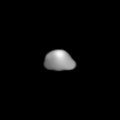22 Kalliope
22 Kalliope is a big main belt asteroid of the M-type, found by J. R. Hind on November 16, 1852. It is named after Calliope, the Greek Muse of epic poetry.
| Discovery | |
|---|---|
| Discovered by | John Russell Hind |
| Discovery date | November 16, 1852 |
| Designations | |
| none | |
| Main belt | |
| Orbital characteristics | |
| Epoch November 12, 2005 (JD 2453686.5) | |
| Aphelion | 479.931 Gm (3.208 AU) |
| Perihelion | 390.433 Gm (2.610 AU) |
| 435.182 Gm (2.909 AU) | |
| Eccentricity | 0.103 |
| 1812.245 d (4.96 a) | |
Average orbital speed | 17.42 km/s |
| 303.545° | |
| Inclination | 13.710° |
| 66.240° | |
| 356.172° | |
| Physical characteristics | |
| Dimensions | 215×180×150 km [1][2] |
| Mass | 6.3 ± 0.5 ×1018 kg [3][4] |
Mean density | 2.03 ± 0.16 g/cm³ [3] |
| 0.038 m/s² | |
| 0.09 km/s | |
| 0.1728 d (4.148 h) [5] | |
| Albedo | 0.142 [1] |
| Temperature | ~161 K max: 240 K (-32°C) |
Spectral type | M [6] |
| 6.45 | |
Characteristics
Kalliope is about 180 km in diameter but is not perfectly round, as shown by images from the VLT at the European Southern Observatory [7]
Its spectrum is M-type, but Kalliope does not appear to be metallic. It is similar to other M-types such as 21 Lutetia. Firstly, its density is far too low to be metal. Second, spectroscopic studies have shown evidence of hydrated minerals [8] and silicates,[9] so the surface is probably stony. Kalliope also has a low radar albedo,[4] unlike most metallic surfaces.
Lightcurve analysis indicates that Kalliope's pole most likely points towards ecliptic coordinates (β, λ) = (-23°, 20°) with a 10° uncertainty,[2][3] which gives Kalliope an axial tilt of 103°. Kalliope's rotation is then a bit retrograde.
Moon
Kalliope has one known moon, Linus, or (22) Kalliope I Linus. It is quite big: 30–40 km in diameter. It orbits about 1065 km from Kalliope. This is about 12 times the radius of Kalliope. Linus was found on August 29, 2001 by Jean-Luc Margot and Michael E. Brown, while another team also independently found the moon 3 days later.[7]
22 Kalliope Media
References
- ↑ 1.0 1.1 "Supplemental IRAS Minor Planet Survey". Archived from the original on 2006-06-23. Retrieved 2007-12-19.
- ↑ 2.0 2.1 M. Kaasalainen; et al. (2002). "Models of Twenty Asteroids from Photometric Data" (PDF). Icarus. 159 (2): 369. doi:10.1006/icar.2002.6907. Archived from the original (PDF) on 2008-02-16. Retrieved 2007-12-19.
- ↑ 3.0 3.1 3.2 F. Marchis; et al. (2003). "A three-dimensional solution for the orbit of the asteroidal satellite of 22 Kalliope". Icarus. 165 (1): 112. Bibcode:2003Icar..165..112M. doi:10.1016/S0019-1035(03)00195-7.
- ↑ 4.0 4.1 J.L. Margot & M.E. Brown (2003). "A Low-Density M-type Asteroid in the Main Belt". Science. 300 (5627): 1939–1942. Bibcode:2003Sci...300.1939M. doi:10.1126/science.1085844. PMID 12817147. S2CID 5479442.
- ↑ "PDS lightcurve data". Archived from the original on 2006-06-14. Retrieved 2007-12-19.
- ↑ "PDS spectral class data". Archived from the original on 2010-01-17. Retrieved 2007-12-19.
{{cite web}}: CS1 maint: bot: original URL status unknown (link) - ↑ 7.0 7.1 synthesis of several observations including recent ones with the VLT 8m telescope.
- ↑ A.S. Rivkin; et al. (2000). "The nature of M-class asteroids from 3-micron observations". Icarus. 145 (2): 351. Bibcode:2000Icar..145..351R. doi:10.1006/icar.2000.6354.
- ↑ D.F. Lupishko; et al. (1982). "UBV photometry of the M-type asteroids 16 Psyche and 22 Kalliope". Solar System Research. 16: 75.
Other websites
- Kalliope and Linus very well resolved with the 8m VLT at ESO. Also includes a Kalliope shape model.
- shape model deduced from lightcurve Archived 2008-02-16 at the Wayback Machine
- orbit diagram for Linus Archived 2006-06-15 at the Wayback Machine
- A different VLT image of Kalliope and Linus Archived 2006-09-28 at the Wayback Machine
- Data sheet at Johnston's Archive, includes some other parameters.
